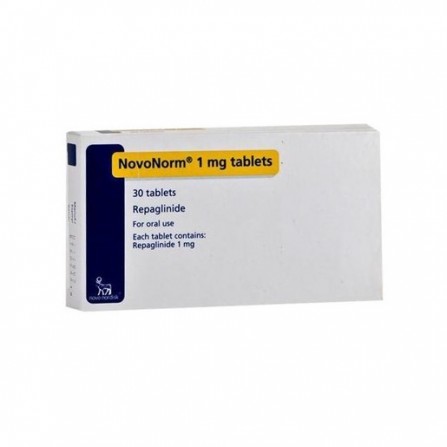More info
Description
Novonorm pills - oral hypoglycemic agent. Rapidly reduces blood glucose by stimulating insulin release from functioning pancreatic β-cells. The mechanism of action is associated with the ability to block ATP-dependent channels in β-cell membranes due to exposure to specific receptors, which leads to cell depolarization and the opening of calcium channels. As a result, an increased calcium influx induces insulin secretion by β-cells. After taking repaglinide, the insulinotropic response to food intake is observed for 30 minutes, which leads to a decrease in blood glucose levels. There is no increase in insulin concentration between meals. In patients with type 2 diabetes mellitus (insulin-dependent), when taking repaglinide in doses of 500 mcg to 4 mg, a dose-dependent decrease in blood glucose level is noted.
Active ingredients
Repaglinide
Release form
Pills
Composition
Repaglinide, poloxamer 188, povidone, meglumine, corn starch, anhydrous calcium hydrogen phosphate, microcrystalline cellulose (E460), glycerol 85% (glycerin), potassium polacrilin (potassium polyacrylate), magnesium stearate, iron yellow oxide (E172).
Indications
Diabetes mellitus type 2 (insulin-independent) with the ineffectiveness of diet therapy, weight loss and exercise. In patients with type 2 diabetes, repaglinide can also be used in combination with metformin in cases where satisfactory glycemic control cannot be achieved with repaglinide or metformin monotherapy.
Precautionary measures
Before use, it is recommended to consult a doctor.
Use during pregnancy and lactation
Use during pregnancy and lactation is contraindicated. In experimental studies it was established that there is no teratogenic effect, however, when used in high doses in rats in the last stage of pregnancy, embryotoxicity was observed, impairment of limb development in the fetus. Repaglinide is excreted in breast milk.
Dosage and administration
The dosage regimen is set individually, adjusting the dose in order to optimize the glucose level. The recommended starting dose is 500 μg.The dose should be increased no earlier than 1-2 weeks of continuous use, depending on the laboratory parameters of carbohydrate metabolism. Maximum doses: single - 4 mg, daily - 16 mg. After using another hypoglycemic drug, the recommended initial dose is 1 mg. each main meal. The optimal time for taking the drug is 15 minutes before a meal, but can be taken 30 minutes before a meal or just before a meal.
Side effects
On the part of metabolism: the effect on carbohydrate metabolism - hypoglycemic states (pallor, increased sweating, palpitations, sleep disorders, tremors), fluctuations in blood glucose levels can cause temporary visual acuity, especially in the beginning of treatment required the abolition of the drug). From the digestive system: abdominal pain, diarrhea, nausea, vomiting, constipation, in some cases - increased activity of liver enzymes. Allergic reactions: itching, erythema, urticaria.
Interaction with other drugs
Enhancement of the hypoglycemic effect of repaglinide is possible with the simultaneous use of MAO inhibitors, non-selective beta-adrenergic blockers, ACE inhibitors, salicylates, NSAIDs, octreotide, anabolic steroids, ethanol. , thyroid hormones, sympathomimetics (when prescribing or canceling these drugs, you must carefully monitor the state of carbohydrate bmen). In case of simultaneous use of repaglinide with drugs that are mainly excreted in the bile, the potential interaction between them should be considered. Pharmacokinetic interaction In connection with the available data on the repaglinide metabolism by the CYP3A4 isoenzyme, a possible interaction with CYP3A4 inhibitors (ketoconazole, intraconazole, err, an eld err should be considered; fluconazole, mibefradil), leading to an increase in the level of repaglinide in plasma. Inductors CYP3A4 (including rifampicin, phenytoin) can reduce the concentration of repaglinide in the plasma. Since the degree of induction has not been established the simultaneous use of repaglinide with these drugs is contraindicated.
special instructions
Contraindications to the use of: diabetes mellitus type 1 (insulin-dependent), diabetic ketoacidosis (includingwith a comatose state), severe renal dysfunction, severe liver dysfunction, concomitant medication with CYP3A4 inhibiting or inducing drugs, pregnancy (including planned), lactation, hypersensitivity to repaglinide. In diseases of the liver or kidneys, extensive surgery, recent illness or infection, it is possible to reduce the effectiveness of repaglinide. Use with caution in patients with kidney disease. In weakened patients or in patients with reduced nutritional levels, repaglinide should be taken in minimal initial and maintenance doses. To prevent hypoglycemic reactions in this category of patients, the dose should be selected with caution. The emerging hypoglycemic states are usually reactions of moderate severity and are easily stopped by carbohydrate intake. In severe conditions it may be necessary to / in the introduction of glucose. The likelihood of such reactions depends on the dose, dietary habits, intensity of physical exertion, stress. It should be borne in mind that beta-blockers may mask the symptoms of hypoglycemia. During treatment, patients should refrain from drinking alcohol, because ethanol can enhance and prolong the hypoglycemic effect of repaglinide. Effect on the ability to drive motor vehicles and control mechanisms. Against the background of repaglinide, it is necessary to evaluate the feasibility of driving a car or practicing other potentially dangerous activities.



